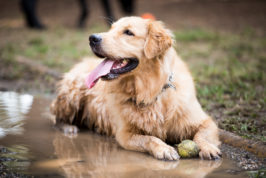Why is my old dog skinny?
As our beloved canine companions get older, it’s certainly not unusual for their body shape to change. They can become less well-muscled and sometimes even skinny. But just because it’s common for dogs to lose weight as they get older, doesn’t mean it’s normal or, most importantly, that nothing can be done to get your senior pooch to a healthy weight again. Dr Hannah Godfrey explains how to recognise whether your dog is skinny, and the possible causes in older age.
How do I know if my old dog is too thin?
When older dogs lose weight, it tends to be lost from certain areas more than others. A Body Condition Score, which allows you to feel the fat layer (or lack of) along the spine, ribs and waist, can be very useful as a starting point. However, older dogs can lose fat pads from behind their eyes, and often lose muscle from their forehead and hips, so checking for sunken eyes, dents in their forehead region, and skinnier hips may give you a better idea.
What causes old dogs to become thin?

If you have an older dog who has lost some weight, but you haven’t changed their diet or exercise routine, there are some other possible causes for the weight loss, rather than just ‘getting old’. Speak to your vet if you’re concerned that your canine companion is losing pounds as they gain in years. They will be able to determine if one of the following conditions is the cause:
Kidney Disease
With advancing age, some of the internal organs can start to struggle. One of the reasonably common age-related health conditions is kidney insufficiency, or ‘Chronic Kidney Disease’, where the kidneys become less capable of removing waste products from the body in the form of urine.
As well as weight loss, symptoms of Chronic Kidney Disease can include an increase in drinking and urination, reduced appetite, lethargy, vomiting and smelly breath. If CKD is suspected, your vet will take a blood sample to confirm the diagnosis.
Once confirmed, there are prescription diets that can help to slow the deterioration of the kidneys, and your vet might recommend that your dog stays at the practice for a few days on a drip if they are particularly poorly. Although the parts of the kidney that have stopped working cannot be fixed, with the correct management dogs with kidney disease can remain stable for months or longer.
Liver Disease
There are many causes of Liver Disease and infection, inflammation, blockage of the bile duct and poisons are just some examples. Sometimes, the liver doesn’t recover fully and becomes gradually less able to function.
Alongside weight loss, other symptoms of chronic liver disease could include:
- Vomiting
- Diarrhoea
- Lethargy
- Increased thirst and urination
- Reduced appetite
- Swollen abdomen
- Yellow colour to the skin, eyes and gums
Some treatments can help to heal or support the liver, which your vet may be able to prescribe following a blood test. They might recommend your dog stays overnight to have fluids through a drip and medication to reduce nausea and improve their appetite. Some stages and causes of Liver Disease are reversible, but others are not.
Diabetes
Just like humans, dogs can develop Diabetes, which is when the body doesn’t produce enough insulin to keep the blood sugar at a healthy level. Although Diabetes doesn’t only occur in elderly dogs, it’s uncommon in young dogs.
If your dog is diabetic, you might notice them drinking and passing urine excessively and eating more but losing weight, despite their good appetite. If your dog has been diabetic for a little while without treatment, you might also notice white cataracts in the eyes.
Once confirmed with a blood test, Diabetes can be treated with insulin injections, given twice daily under the skin. These injections will need to be given for the rest of the dog’s life, but once under control, dogs can regain weight and energy, and have a good quality of life.
Arthritis
Although Arthritis is often associated with weight gain, due to the impact on a dog’s mobility, it can sometimes cause weight loss. In this case, it isn’t fat that is being lost – the reduction in exercise leads to muscle loss. If weight loss is due to Arthritis, the ‘skinny’ areas tend to be around the hips and thighs, although other areas can be affected.
Getting and keeping your dog mobile is the key to preventing muscle wastage in Arthritis. Your vet will be able to help you with pain relief, and you might want to start some joint supplements to provide the joints with the nutrients they need to repair themselves.
Cancer
Sadly, as dogs get older, they are more likely to develop tumours and cancers, as is the case with people. The other symptoms associated with a tumour will vary depending on where in the body the tumour is. Your vet will be able to do a full examination of your dog if you’re concerned about weight loss, and this will help to decide whether any more tests are necessary.
Unfortunately, weight loss associated with Cancer often carries a poor prognosis. Whilst some tumours can be operated on, others may need chemotherapy or radiotherapy. Your vet will talk you through all the options associated with your dog’s tumour if this proves necessary.
Conclusion
Although there are many causes of reduced weight in older dogs, just being old is not one of them. Remember that many of the causes are treatable, especially if caught early. Making an appointment with your vet is key if you’re concerned about your dog losing weight, as it’ll help to get them back on the road to good health.




